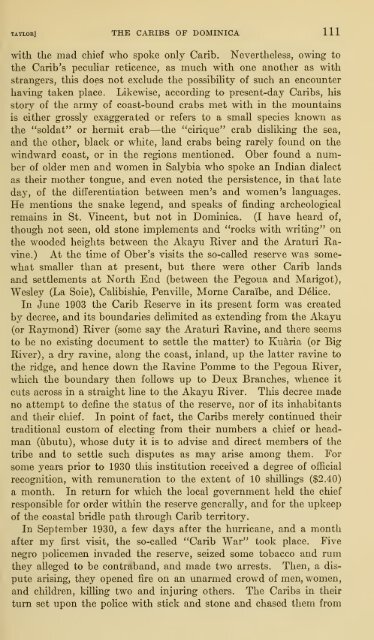Create successful ePaper yourself
Turn your PDF publications into a flip-book with our unique Google optimized e-Paper software.
TAYLOR] THE CARIES OF DOMINICA 111<br />
with the mad chief who spoke only Carib. Nevertheless, owing to<br />
the Carib's peculiar reticence, as much with one another as with<br />
strangers, this does not exclude the possibility <strong>of</strong> such an encounter<br />
having taken place. Likewise, according to present-day <strong>Caribs</strong>, his<br />
story <strong>of</strong> the army <strong>of</strong> coast-bound crabs met with in the mountains<br />
is either grossly exaggerated or refers to a small species known as<br />
the "soldat" or hermit crab—the "cirique" crab disliking the sea,<br />
and the other, black or white, land crabs being rarely found on the<br />
windward coast, or in the regions mentioned. Ober found a number<br />
<strong>of</strong> older men and women in Salybia who spoke an Indian dialect<br />
as their mother tongue, and even noted the persistence, in that late<br />
day, <strong>of</strong> the differentiation between men's and women's languages.<br />
He mentions the snake legend, and speaks <strong>of</strong> finding archeological<br />
remains in St. Vincent, but not in <strong>Dominica</strong>. (I have heard <strong>of</strong>,<br />
though not seen, old stone implements and "rocks with writing" on<br />
the wooded heights between the Akayu River and the Araturi Ravine.)<br />
At the time <strong>of</strong> Ober's visits the so-called reserve was somewhat<br />
smaller than at present, but there were other Carib lands<br />
and settlements at North End (between the Pegoua and Marigot),<br />
Wesley (La Sole), Calibisliie, Penville, Morne Caraibe, and Delice.<br />
In June 1903 the Carib Reserve in its present form was created<br />
by decree, and its boundaries delimited as extending from the Akayu<br />
(or Raymond) River (some say the Araturi Ravine, and there seems<br />
to be no existing document to settle the matter) to Kuaria (or Big<br />
River), a dry ravine, along the coast, inland, up the latter ravine to<br />
the ridge, and hence down the Ravine Pomme to the Pegoua River,<br />
which the boundary then follows up to Deux Branches, whence it<br />
cuts across in a straight line to the Akayu River. This decree made<br />
no attempt to define the status <strong>of</strong> the reserve, nor <strong>of</strong> its inhabitants<br />
and their chief. In point <strong>of</strong> fact, the <strong>Caribs</strong> merely continued their<br />
traditional custom <strong>of</strong> electing from their numbers a chief or headman<br />
(ilbutu), whose duty it is to advise and direct members <strong>of</strong> the<br />
tribe and to settle such disputes as may arise among them. For<br />
some years prior to 1930 this institution received a degree <strong>of</strong> <strong>of</strong>ficial<br />
recognition, with remuneration to the extent <strong>of</strong> 10 shillings ($2.40)<br />
a month. In return for which the local government held the chief<br />
responsible for order within the reserve generally, and for the upkeep<br />
<strong>of</strong> the coastal bridle path through Carib territory.<br />
In September 1930, a few days after the hurricane, and a month<br />
after my first visit, the so-called "Carib War" took place. Five<br />
negro policemen invaded the reserve, seized some tobacco and rum<br />
they alleged to be contraband, and made two arrests. <strong>The</strong>n, a dispute<br />
arising, they opened fire on an unarmed crowd <strong>of</strong> men, women,<br />
and children, killing two and injuring others. <strong>The</strong> <strong>Caribs</strong> in their<br />
turn set upon the police with stick and stone and chased them from

















